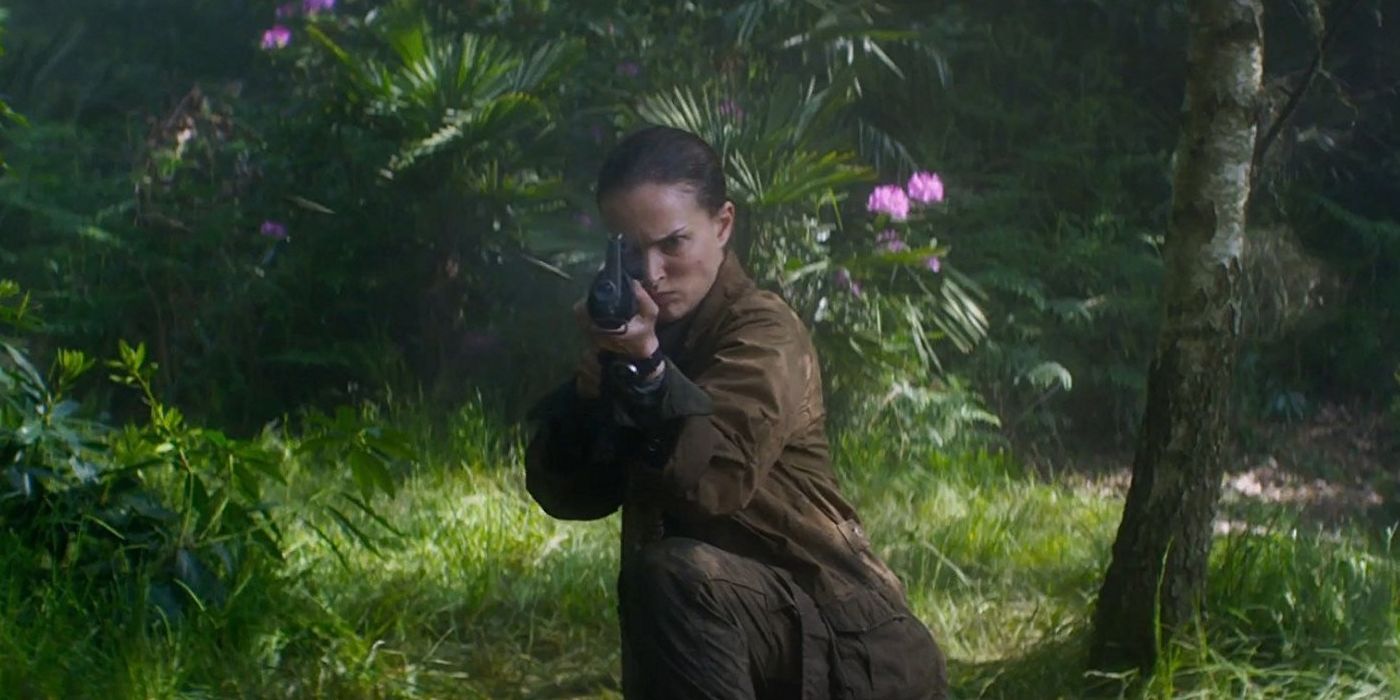Summary
-
Annihilation
, both the book and the film, present a story with different perspectives and approaches to the central plot device of Area X. - The film adaptation of
Annihilation
prioritizes action and explores themes of cancerous growth and trauma, while the book focuses on human isolation and the internal transformation of the protagonist. - Hollywood adaptations often change elements of the source material to cater to a wider audience, but the true intent and richness of the story can only be fully appreciated by exploring the source material.
Following up Alex Garland’s 2014 sci-fi sleeper hit Ex Machina, 2018’s Annihilation is an odd duck of a movie when it comes to its place in the cultural zeitgeist. A massive critical hit, the film is perhaps best known by sci-fi and horror fans for its mind-bending visuals, ambiguous plot device (the Shimmer), and standout moments of shock, horror, and beauty all at once. The infamous bear scene, and Ben Salisbury’s standout track, “The Alien,” are two moments from the film that have etched their way into mainstream consciousness, even if the larger vehicle may have fallen behind a bit. But what is Annihilation, and where did it come from?
As is often the case in Hollywood, there was a book before there was a film. Jeff VanderMeer’s eponymous book is actually the first of a trilogy (all three books comprising Annihilation, Authority, and Acceptance), which was still being written when Paramount Pictures and Scott Rudin acquired the rights for the film back in 2013. Garland was brought on board to write and direct, given only a manuscript of the first. The books were all released over the course of 2014, and all operate as three parts of a single whole, rather than ongoing chapters in a larger saga.
Annihilation: Book Versus Film
The book version of Annihilation follows a similar story structure to the Alex Garland film, but the two versions of the narrative approach its characters and the central plot device — Area X — from very different points of view. To quickly summarize, the story follows an expedition (specifically the 12th expedition) of four women — a biologist, a psychologist, an anthropologist, and a surveyor — as they traverse the mysterious landscape of Area X: an ecological anomaly with no discernible explanation for what happens within it, just that people go in and rarely come out the same, if at all. The entire novel is told from the biologist’s point of view, and is intentionally structured like a series of journal entries during her time within this pristine wildlife enclosure.
As a novel, Annihilation is beautiful, as it is brutal in its descriptions of Area X as well as the biologist’s own state of mind and personal history. It also plays with themes of human isolation, ecological protection, and the limitations of the human mind through its prose. There are only a few constants that the book sticks to: one, that nobody from the 12th expedition is given a name outside their function; two, that Area X is most definitely alive, and is responding to whatever human stimuli make its way into it; and three, that the biologist’s antisocial nature and intense draw to the natural world makes her a perfect fit within this ecosystem.
There are a few other elements that keep coming back into the fold even in later entries, namely the mystery of a lighthouse that is inexplicably linked to a burrowing tower (or tunnel) into the ground, whose walls are lined with some strange Biblical prose that seems to be made up entirely of some kind of fungi. There is also a mysterious moaning creature that makes its presence felt every now and again, mostly appearing as a short hurdle for our biologist towards the end of the novel, but the story is largely an internal one, dealing with the biologist’s own biases and how Area X begins to transform her from within.
In the film adaptation of Annihilation, many of these elements are drastically changed or replaced with elements that are similar, but serve a different function entirely. Where the novel is concerned with humanity’s fight for relevance against nature’s will, Garland’s film deals more with ideas of cancerous growth and the trauma that comes with it. In the film, almost all three constants from the book are upended: the characters all have names and histories, Area X’s mysteries are more direct (citing it as a giant prism that refracts biology, causing inexplicable growths and changes, a la cancer cells), and our biologist (Lena, here), though tight-lipped, is a much more agreeable protagonist with easier goals to root for.
The film also foregoes the book’s insistence on the expedition members going largely gun-free, but it would be difficult to sell a multi-million dollar horror sci-fi exploration film without some promise of action. All this is not to say that the film is bad or that any of these elements detract from the story, but the story itself then fundamentally changes.
Adapting Vagueness into Film
Garland has stated that he deliberately wrote “a memory of the book” (per CNET), focusing more on capturing its tone and “dreamlike nature” rather than following its exact plot. Structurally, the book version of Annihilation is fairly linear in its approach to the narrative, using the biologist as a vehicle to not only paint a picture of Area X and her fellow compatriots, but also her own difficult past with her family and her husband, weaving memory and present actions together to tell a story that seems fairly visual. The most difficult part to adapt, however, seems to be the protagonist’s transformation — more physical than internal — described as a growing “brightness” that makes her more attuned to the silent language of Area X.
To say that Annihilation, as a story, is impossible to adapt is its own can of worms, but often Hollywood does tend to rewire an existing story’s bones and retrofit it to spin its own narrative. Despite the similarities of set-up, the book and the film adaptation take very different paths as we explored above — a factor that has mostly been to the detriment of the story for fans of either medium, hoping to gain something more from the other.
People who discovered the film first went into the novel expecting a similar cause-and-effect string of events, where we slowly uncover the secrets of Area X along with our core-four, until they get picked off one-by-one. The book, unfortunately, is simultaneously less eventful and more deliberate, both from a character and a reader’s standpoint, and often tends to blend poetry, prose, science, and geography together to make a very specific concoction that doesn’t lend itself to an easy first read. Book readers, on the other hand, were expecting a more cerebral film, featuring core moments from the book like the tower (or tunnel), the lighthouse and the moaning creature (only two of which were loosely adapted to grace the silver screen).
But the nature of book-to-film adaptation, especially a Hollywood adaptation, is change. Almost every filmmaker that adapts a novel to film is forced to make a number of changes, both large and small, for hundreds of reasons, which are actually all part of one big reason, which is: how will I get an audience to watch this? While the rhythm of novels can be largely dictated by a reader’s own pace, films don’t have that same luxury and are often forced to change or remove elements entirely in favor of the best way to get from Point A to Point B without losing their audience. Films often have to prioritize plot over structure, which is why Annihilation is such a rare case where the writer/director intentionally ensured that the tone of the book remains the same despite the numerous changes to the plot.
Films Legitimizing Story
There is often a silent belief that novels adapted to film are “legitimized” in some way, as if the act of putting a story on-screen for mass consumption then makes the story better because of its accessibility. Hollywood has been performing this act not just for adaptations, but animated films as well, often revising plot points and segments that could be misread or haven’t aged the best, while still holding onto the bones of the story. To adapt is to change, and that’s not necessarily a bad thing. So many films have lifted their source material thanks to helpful changes made in the page-to-screen process, with a number of authors relinquishing the rights of these stories over to their film counterparts.
But as an audience, it can be easier for us to absorb what we see on screen and take it as the final say in the way these stories should be told. What we must remember is that Hollywood adaptations are often more akin to visual book reports than the core stories themselves. The source material is the true intent, and every reproduction since is usually some form of reaction to that very idea that the author birthed.
With Annihilation, the movie acts as a fantastic introduction to VanderMeer’s rich world of the Southern Reach, and fans of the movie should definitely take out some time to check out its source material. There is so much more to the story than meets the eye.
Stream Annihilation on Paramount+
This story originally appeared on Movieweb



